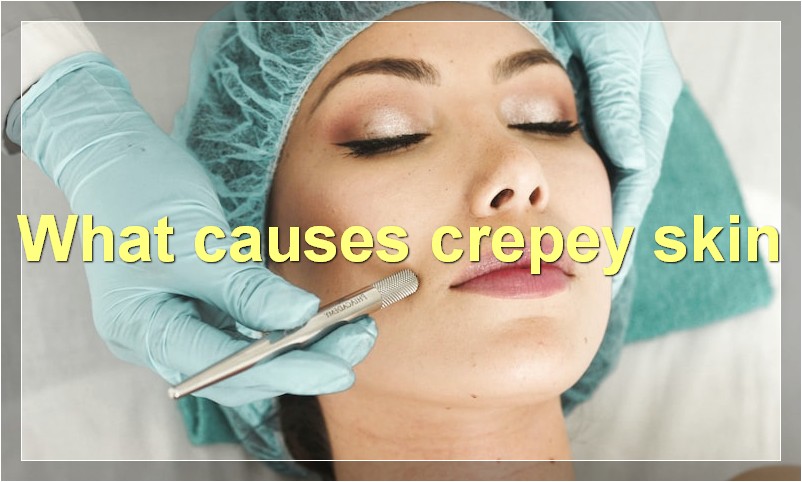As we age, our skin loses collagen and elasticity, which can cause it to sag and develop wrinkles. But there are ways to prevent and treat crepey skin! Here are the best products, causes, prevention, and treatment for crepey skin.
What are the best products for crepey skin
If you’re looking for the best products to help improve the appearance of crepey skin, you’ve come to the right place. Here, we’ve rounded up a few of our favorite products that can help hydrate, smooth, and plump the skin.
First up is a hyaluronic acid-based serum, like SkinCeuticals Hydrating B5 Gel. This lightweight gel helps to bind moisture to the skin, giving it a plumper, more youthful appearance.
Next is a rich, emollient cream like Natura Bisse The Cure Sheer Cream. This luxurious formula contains shea butter and jojoba oil to deeply hydrate and nourish the skin.
For an extra boost of hydration, try a hydrating facial mask like Skyn Iceland Hydro Cool Firming Face Gels. These cooling gel masks are infused with Icelandic glacial water and aloe vera to instantly hydrate and soothe the skin.
Finally, if you want to give your skin a little pick-me-up, try using a jade roller or gua sha tool. These ancient beauty tools help to promote circulation and lymphatic drainage, giving the skin a more radiant, healthy appearance.
What causes crepey skin

Crepey skin is a condition characterized by thin, sagging skin that has the appearance of being wrinkled or crinkled. It is most commonly found on the face, neck, upper arms, and thighs. While crepey skin can be caused by a number of factors, including aging, sun damage, and dehydration, one of the main culprits is a lack of collagen and elastin in the skin.
Collagen and elastin are two proteins that give skin its firmness and elasticity. As we age, our bodies produce less of these proteins, resulting in skin that is thinner and less able to withstand the forces of gravity. This can cause the formation of wrinkles and creases in the skin.
Sun damage is another major factor that can lead to crepey skin. Ultraviolet (UV) rays from the sun can break down collagen and elastin fibers in the skin, which leads to a loss of structure and strength. This can cause the skin to become thin, saggy, and wrinkled.
Dehydration can also contribute to the formation of crepey skin. When the skin is not properly hydrated, it can become dry and fragile, which makes it more susceptible to wrinkling and sagging.
While there is no single cure for crepey skin, there are a number of things you can do to improve its appearance. These include:
• Using a sunscreen with an SPF of 30 or higher to protect your skin from further sun damage.
• Applying a moisturizer regularly to keep your skin hydrated.
• Exfoliating your skin regularly to remove dead skin cells and promote new cell growth.
• Getting enough sleep and managing stress levels to promote healthy skin function.
• Eating a healthy diet that includes plenty of fruits, vegetables, and lean protein.
How can I prevent crepey skin
If you’re concerned about crepey skin, there are a few things you can do to prevent it and keep your skin looking its best. First, make sure you’re protecting your skin from the sun by wearing sunscreen every day. ultraviolet (UV) rays can damage the collagen in your skin, causing it to become thinner and more fragile.
Second, don’t smoke. Smoking damages the skin’s elasticity, making it more likely to develop creases and wrinkles.
Third, use a gentle cleanser on your face and avoid scrubbing or using harsh exfoliants. Cleansing too vigorously can strip away the natural oils that keep your skin healthy.
Finally, eat a healthy diet and drink plenty of water. Foods that are rich in antioxidants like berries and green leafy vegetables can help protect your skin from damage. And staying hydrated is essential for keeping your skin looking plump and supple.
How do I treat crepey skin
If you’re concerned about crepey skin, you’re not alone. This common skin concern can affect anyone, regardless of age or skin type. While there’s no one-size-fits-all solution for crepey skin, there are a few things you can do to help improve its appearance.
First, it’s important to understand what crepey skin is and what causes it. Crepey skin is thin, fragile skin that often has a wrinkled or crumpled appearance. It’s most commonly found on the face, neck, hands, and arms.
There are a number of factors that can contribute to the development of crepey skin, including sun damage, smoking, dehydration, and aging. If you have any of these risk factors, it’s important to take extra care of your skin to help prevent or minimize the appearance of crepey skin.
Here are a few tips to help improve the appearance of crepey skin:
1. Use sunscreen regularly. Sun exposure is one of the main culprits behind crepey skin. To help protect your skin from the sun’s harmful rays, be sure to apply sunscreen every day, even when it’s cloudy outside. Look for a sunscreen with an SPF of at least 30 and be sure to reapply it every two hours or as directed on the package.
2. Stay hydrated. Drinking plenty of water is essential for healthy skin, but it’s especially important if you’re trying to improve the appearance of crepey skin. Be sure to drink eight glasses of water each day to keep your skin hydrated from the inside out.
3. Use a humidifier. Dry air can contribute to the development of crepey skin. To help keep your skin hydrated, use a humidifier in your home or office. This will help add moisture to the air and prevent your skin from drying out.
4. Apply a topical retinoid cream. Topical retinoids are vitamin A derivatives that can help improve the appearance of fine lines and wrinkles, including those caused by crepey skin. Retinoids work by increasing cell turnover and stimulating collagen production. You can find topical retinoids over the counter or by prescription from your dermatologist.
5. Get regular facials. Facials can help improve the appearance of crepey skin by exfoliating dead skin cells and promoting collagen production. Look for a facial that includes ingredients like glycolic acid or lactic acid to help exfoliate your skin and improve its overall appearance.
6. Try microdermabrasion. Microdermabrasion is a cosmetic procedure that uses fine crystals to exfoliate the top layer of skin. This can help improve the appearance of crepey skin by making it look smoother and more evenly toned. Microdermabrasion is usually done by a professional dermatologist or esthetician and typically requires multiple treatments to see results.
7. Use a hyaluronic acid serum. Hyaluronic acid is a substance that occurs naturally in the body and helps keep your skin hydrated and plump. You can find hyaluronic acid serums over the counter or by prescription from your dermatologist. Apply a small amount of serum to your face once or twice daily after cleansing for best results.
8. Consider laser therapy. Laser therapy can help improve the appearance of crepey skin by stimulating collagen production and improving skin elasticity. There are a variety of different laser treatments available, so be sure to discuss your options with your dermatologist to find one that’s right for you
Is there a cure for crepey skin
Crepey skin is a condition characterized by thin, sagging skin that has the appearance of crinkled paper. The condition is most often seen on the face, neck, hands, and legs. While crepey skin can occur at any age, it is more common in older adults. There are several factors that can contribute to the development of crepey skin, including sun damage, smoking, poor nutrition, dehydration, and certain medical conditions.
There is no single “cure” for crepey skin. However, there are several things you can do to improve the appearance of your skin. These include:
• Use a moisturizer: Moisturizing your skin will help to plump up the skin cells and reduce the appearance of wrinkles. Look for a moisturizer that contains hyaluronic acid or glycerin.
• Apply a retinoid cream: Retinoids are vitamin A derivatives that can stimulate collagen production and help to thicken the skin. You can find retinoid creams over the counter or by prescription.
• Get laser treatments: Laser treatments can help to tighten loose skin and reduce the appearance of wrinkles.
• Try microneedling: Microneedling is a procedure that involves using fine needles to create tiny punctures in the skin. This can stimulate collagen production and help to improve the appearance of crepey skin.
If you are concerned about the appearance of your skin, talk to your doctor about your options.
What is the best way to moisturize crepey skin

As we age, our skin goes through a lot of changes. One of the most common changes is that our skin becomes thinner and less elastic. This can cause our skin to become crepey.
There are a lot of different ways to moisturize crepey skin. But, what is the best way?
Here are a few things to consider when choosing a moisturizer for crepey skin:
1. Look for something that is oil-free.
2. Choose a thicker cream or ointment rather than a lotion.
3. Pick a product that contains hyaluronic acid or glycerin.
4. Avoid fragrances, dyes, and other harsh ingredients.
5. Use a sunscreen with an SPF of 30 or higher during the day.
6. Apply your moisturizer twice a day, morning and night.
7. Be patient! It may take several weeks to see results.
The best way to moisturize crepey skin is to use a combination of these tips. Find a product that meets as many of these criteria as possible and give it time to work. You’ll soon see your skin looking healthier and more youthful!
What is the best way to exfoliate crepey skin
Exfoliating crepey skin can be difficult because this type of skin is typically very dry and delicate. However, with the right products and techniques, you can slough away dead skin cells and reveal softer, smoother skin underneath.
The best way to exfoliate crepey skin is to use a gentle exfoliating scrub. Look for a scrub that contains small, fine particles that will not scratch or irritate your skin. Apply the scrub to clean, damp skin and massage it in using circular motions. Rinse away the scrub with lukewarm water and pat your skin dry.
If you have sensitive skin, you may want to avoid scrubs altogether. Instead, try using a chemical exfoliant. Chemical exfoliants contain ingredients like glycolic acid or lactic acid, which help to dissolve dead skin cells. Apply a chemical exfoliant to your face using a cotton pad or your fingers, being careful to avoid the sensitive area around your eyes. Rinse away the exfoliant with lukewarm water and follow up with a moisturizer.
For an extra boost of hydration, try using a hyaluronic acid serum before applying your moisturizer. Hyaluronic acid is a ingredient that helps to attract and retain moisture in the skin. Apply a few drops of hyaluronic acid serum to your face and massage it in until it is fully absorbed. Follow up with your regular moisturizer.
If you have very dry, crepey skin, you may need to exfoliate more frequently than someone with normal or oily skin. Try exfoliating two or three times per week until your skin starts to look and feel smoother. Then, you can reduce the frequency of exfoliation as needed.
What are some natural remedies for crepey skin
As we age, our skin changes. One common change is the development of crepey skin, which can give our skin a thin, crinkled, and saggy appearance.
There are a number of factors that contribute to the development of crepey skin, including sun damage, smoking, poor nutrition, dehydration, and exposure to environmental toxins.
While there’s no way to completely prevent crepey skin, there are some natural remedies that can help to improve its appearance.
1. Coconut oil
Coconut oil is rich in fatty acids that help to keep skin moisturized and supple. It also contains antioxidants that protect the skin from damage.
To use coconut oil as a natural remedy for crepey skin, simply massage it into the affected area twice daily.
2. Aloe vera
Aloe vera is another natural ingredient that’s often used to treat skin conditions. It’s rich in vitamins and minerals that nourish the skin and it also has anti-inflammatory properties that can help to reduce swelling and redness.
To use aloe vera as a natural remedy for crepey skin, apply it to the affected area twice daily. You can either use a store-bought aloe vera gel or extract the gel from a fresh aloe vera leaf.
3. Witch hazel
Witch hazel is a plant that’s been used medicinally for centuries. It’s well known for its astringent properties, which make it an effective natural remedy for treating various skin conditions, including crepey skin.
To use witch hazel as a natural remedy for crepey skin, apply it to the affected area with a cotton ball twice daily. You can either use a store-bought witch hazel solution or make your own by boiling one cup of water and adding two tablespoons of dried witch hazel leaves. Let the mixture steep for 15 minutes before straining it and applying it to your skin.
4. Vitamin C serum
Vitamin C is an essential nutrient for healthy skin. It helps to boost collagen production and protect the skin from damage caused by free radicals. Vitamin C serums are available commercially or you can make your own by mixing one part vitamin C powder with two parts water. Apply the serum to your face once daily after cleansing.
5. Glycerin
Glycerin is a humectant, which means it helps to keep moisture in the skin. This makes it an effective natural remedy for dry, crepey skin. You can purchase glycerin at most drugstores or online. Apply glycerin to your face twice daily after cleansing.
Are there any home remedies for crepey skin
Are you concerned about the crepey skin on your face? Have you started to notice fine lines and wrinkles that weren’t there before? If so, you’re not alone. Many people start to see the signs of aging skin in their 30s and 40s. But there’s no need to despair. There are several things you can do to improve the appearance of crepey skin.
First, it’s important to understand what causes this type of skin damage. Crepey skin is thin and delicate, and it lacks the elasticity of younger skin. This is because it’s lacking in collagen and elastin, two proteins that give skin its firmness and flexibility.
There are a number of factors that can contribute to the loss of collagen and elastin, including sun damage, smoking, poor diet, and certain medical conditions. But the good news is that there are steps you can take to boost collagen and elastin production and improve the appearance of your skin.
One of the best things you can do for crepey skin is to use a topical retinoid. Retinoids are derivatives of vitamin A, and they help to stimulate collagen production. They also increase cell turnover, which helps to improve the appearance of fine lines and wrinkles.
If you’re not ready to start using a retinoid, there are other things you can do to help improve the appearance of your skin. Getting plenty of exercise will help to increase blood flow and promote collagen production. Eating a healthy diet that includes plenty of fruits, vegetables, and lean protein will also help. And avoiding tobacco and excessive sun exposure will help to prevent further damage to your skin.
If you’re concerned about the appearance of crepey skin, talk to your dermatologist about your options. There are a number of different treatments available, and your dermatologist can help you find the one that’s right for you.
What are some tips for preventing crepey skin
1. Stay hydrated: Drinking plenty of water helps keep your skin cells plump and hydrated, which can prevent the formation of crepey skin.
2. Eat a healthy diet: Eating a diet rich in antioxidants can help protect your skin from damage that can lead to crepey skin.
3. Get enough sleep: Getting adequate rest helps your body repair damage to your skin cells, which can prevent the formation of crepey skin.
4. Limit sun exposure: Excessive sun exposure can damage your skin cells and lead to the formation of crepey skin.
5. Use sunscreen: Wearing sunscreen with an SPF of 30 or higher can help protect your skin from damage that can lead to crepey skin.
6. Avoid smoking: Smoking damages your skin cells and reduces collagen production, which can lead to crepey skin.
7. Use gentle skincare products: Harsh skincare products can damage your skin and make it more susceptible to creping. Instead, opt for gentle, hydrating products that won’t strip your skin of its natural oils.





